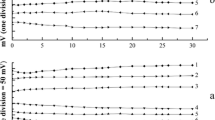Summary
A potentiometric technique for monitoring coulometric titrations of small quantities of bases in 0.1M solution of sodium perchlorate in a mixture of acetic acid and acetic anhydride has been developed. In the indicating system two polarized quinhydrone electrodes are used. The titration end-point is indicated by a potential maximum due to the concentration polarization at the indicating electrodes. The effect of the following factors on the accuracy of the method has been studied: pretreatment of the indicating electrodes, magnitude of the polarization current, generation current, relative position of electrodes in the titration cell and amount of water in the system titrated. Quantities of 2.4 × 10−6–5 × 10−5 equiv of bases were titrated by the method. Errors did not exceed ±2%.
Zusammenfassung
Ein potentiometrisches Verfahren zur kontinuierlichen Kontrolle der coulometrischen Titration kleiner Basenmengen in 0,1-m Na-perchloratlösung in einem Gemisch von Eisessig und Essigsäureanhydrid wurde entwickelt. Als Indikatorsystem wurden zwei polarisierte Chinhydronelektroden benützt. Der Titrationsendpunkt wird durch ein Potential maximum angezeigt, das von der Konzentrationspolarisation an den Elektroden hervorgerufen wird. Die Einflüsse folgender Faktoren auf die Genauigkeit der Methode wurden untersucht: Vorbehandlung der Indikatorelektroden, Größe des Polarisationsstroms und des Generatorstroms, relative Positionen der Elektroden in der Elektrolysezelle und Einfluß vom Wassergehalt des untersuchten Systems.
Mengen von 2,4 · 10−6 bis 5 · 10−5 Val Base können mit dieser Methode titriert werden. Ermittlungsfehler lagen unterhalb ± 2%.
Similar content being viewed by others
References
C. N. Reilley, D. W. Cooke, and H. N. Furman, Analyt. Chemistry23, 1223 (1951).
E. Bishop, Mikrochim. Acta [Wien]1956, 619.
E. Bishop, Analyst83, 212 (1958).
E. Bishop and G. D. Short, Analyst87, 467 (1962).
I. Shain and G. R. Svoboda, Analyt. Chemistry31, 1857 (1959).
G. R. Svoboda, Analyt. Chemistry33, 1638 (1961).
V. Vajgand and T. Pastor, J. Electroanal. Chem.8, 40 (1964).
E. Bishop and G. D. Short, Analyst89, 587 (1964).
W. B. Mather, Jr. and F. C. Anson, Analyt. Chim. Acta21, 468 (1959).
V. J. Vajgand and R. P. Mihajlovic, Talanta16, 1311 (1969).
V. J. Vajgand and T. J. Pastor, Bull. soc. chim. Beograd37, 499 (1972).
Author information
Authors and Affiliations
Rights and permissions
About this article
Cite this article
Vajgand, V.J., Pastor, T.J. & Bjelica, L.J. Use of polarized quinhydrone electrodes for potentiometric end-point detection in continuous coulometric titration of bases in non-aqueous media. Mikrochim Acta 63, 485–492 (1975). https://doi.org/10.1007/BF01217311
Received:
Issue Date:
DOI: https://doi.org/10.1007/BF01217311



